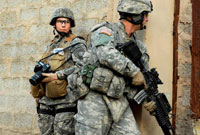Office of Research & Development |
 |


Award-winning military photographer Stacy Pearsall served two ground combat tours in Iraq and was twice wounded by improvised explosive devices (IEDs). When she came home in 2007, the retired Air Force staff sergeant would have to cope with the lingering physical and mental effects of the blasts. Among her medical problems: traumatic brain injury, partial hearing loss, pain in her arm and neck, numbness across one side of her body.
Increasingly, military women like Pearsall are getting plenty close to the action. While women are still formally barred from ground combat, they are attached to combat groups and serving with Ranger and Special Forces units, bunking on submarines, participating in cultural support teams in combat areas, and flying attack helicopters. According to an article in The Atlantic in November 2011, nearly 100 women had been killed in combat zones in the wars in Iraq and Afghanistan.
A recent VA and Department of Defense study affirms that women are being exposed to combat at a significantly higher rate than ever before—and finds that the mental health needs of women who have experienced combat are not significantly different from those of men.
The study, published online in December 2011 in the Journal of Psychiatric Research, examined gender differences in combat exposure and military sexual trauma, and the link between these factors and mental health screening results among personnel deployed to Iraq and Afghanistan. The researchers looked at the records of more than 7,250 active duty soldiers—roughly 6,700 men and 550 women—who presented for health screenings both before and after they were deployed into combat zones.
Psychologist Shira Maguen, PhD, of VA and the University of California, San Francisco, was the study's lead author. "While women technically are not supposed to serve in direct combat, [our] research demonstrates that, in reality, they are experiencing combat at a higher rate than we had assumed," she says. "At the same time, it shows that men and women really don't differ in how they react to the stresses of combat."
Maguen and colleagues looked at four combat-related traumatic experiences: killing; witnessing someone being killed; seeing dead soldiers and civilians; and injury. They believe their study is the first to include gender as a variable in examining responses to these experiences among Veterans returning from Iraq and Afghanistan.
While men whose cases were looked at reported greater exposure to high-intensity combat experiences than women, 4 percent of the women reported having killed an enemy; 9 percent reported witnessing a killing; 31 percent reported having been exposed to death; and 7 percent were injured in a war zone. By comparison, in the 1990-91 Gulf War, 1 percent of women reported killing someone; 14 percent reported witnessing someone dying; and 2 percent suffered a combat-related injury.
Maguen's team found that men and women in combat screened positive for posttraumatic stress disorder at the same rate: 18 percent. However, women injured in combat were more likely to screen positive for PTSD than injured men.
Men who served in combat were more likely to report that they had a drinking problem, while women in combat were more likely to report symptoms of depression. And, while women reported having experienced sexual trauma at a higher rate than men (12 percent versus 1 percent), there was no gender difference in the response to having undergone the trauma—both men and women experienced PTSD and depression as a result.
Maguen believes the study has important implications for the manner in which VA and other health care providers offer care to women Veterans. "If women are indeed being exposed to combat stressors at a higher rate than in prior eras, we have to be prepared to provide the services they need, and take into account the impact that these stressors can have on their mental health functioning. We also need to take a closer look at physical injury and its potential impact on women's psychological health."
As for Stacy Pearsall, despite her injuries, she has been able to build a thriving business around her passion, teaching photography and handling frequent freelance jobs. Just as important, she volunteers her time and talents to a range of Veterans' causes. And she says she is thankful for each day as she continues to recover. When she appeared on Oprah in 2009 on a show dedicated to military members, Pearsall said: "We've lost so many women in this war, but I want people to know, that there's no front line anymore, not in this war, not in Iraq, not in Afghanistan. And since those lines are blurred, women are out there doing the same jobs as men. And whether we like to admit it or not, women are on the front lines, and we are doing the job."